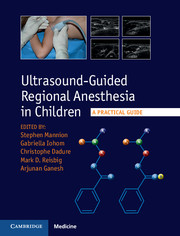Book contents
- Frontmatter
- Contents
- List of contributors
- 1 Introduction
- Section 1 Principles and practice
- Section 2 Upper limb
- 7 Ultrasound-guided axillary brachial plexus block
- 8 Ultrasound-guided supraclavicular brachial plexus block
- 9 Ultrasound-guided infraclavicular brachial plexus block
- 10 Ultrasound-guided interscalene brachial plexus block
- Section 3 Lower limb
- Section 4 Truncal blocks
- Section 5 Neuraxial blocks
- Section 6 Facial blocks
- Appendix: Muscle innervation, origin, insertion, and action
- Index
- References
9 - Ultrasound-guided infraclavicular brachial plexus block
from Section 2 - Upper limb
Published online by Cambridge University Press: 05 September 2015
- Frontmatter
- Contents
- List of contributors
- 1 Introduction
- Section 1 Principles and practice
- Section 2 Upper limb
- 7 Ultrasound-guided axillary brachial plexus block
- 8 Ultrasound-guided supraclavicular brachial plexus block
- 9 Ultrasound-guided infraclavicular brachial plexus block
- 10 Ultrasound-guided interscalene brachial plexus block
- Section 3 Lower limb
- Section 4 Truncal blocks
- Section 5 Neuraxial blocks
- Section 6 Facial blocks
- Appendix: Muscle innervation, origin, insertion, and action
- Index
- References
Summary
Clinical use
Several anatomic and nerve stimulator-guided techniques have been reported when approaching the infraclavicular brachial plexus (Raj et al., 1973; Sims, 1977; Borgeat et al., 2001). In recent years ultrasound-dguided approaches to the infraclavicular plexus have become increasingly popular (Sandhu and Capan, 2002). Below the clavicle in the infraclavicular fossa, the brachial plexus (BP) is arranged into the lateral, medial, and posterior cords. The musculocutaneous, the axillary, and the medial cutaneous nerves all arise from the plexus in this region. Thus, blockade of the BP within the infraclavicular fossa allows for effective block of all nerves of the upper and lower arm with the exception of the intercostobrachial nerve which arises from T2. As such, the infraclavicular BP block is an appropriate and effective regional technique for surgery on the arm, elbow, forearm, and hand.
Block of the plexus at infraclavicular level has several advantages compared to other techniques, including a lower likelihood of tourniquet pain during surgery, more reliable blockade of the musculocutaneous nerve compared to single injection axillary block, and a significantly shorter block performance time compared to multi-injection axillary or mid-humeral blocks (Chin et al., 2013). Additionally, because of the increased depth at which the plexus is encountered compared to the supraclavicular or axillary approach, placement and securing of a continuous catheter may be easier when using the infraclavicular approach. This may be especially important in children whose increased activity level can increase the possibility of catheter dislodgement.
There is evidence that the use of regional anesthesia for surgery on the upper extremity is not infrequent in children. The recently published prospective, observational multicenter study of regional anesthesia practice patterns in the United States published by the Pediatric Regional Anesthesia Network (PRAN) revealed that, of the 14 917 blocks performed over a 3-year period, 3% of blocks were performed for upper extremity surgery (Polaner et al., 2012). Of the 455 single-injection blocks performed on the upper extremity, the infraclavicular approach accounted for 40 blocks and of the 26 upper extremity continuous catheters reported, 8 were performed at the infraclavicular position. In 2010, the survey of the French- Language Society of Pediatric Anesthesiologists (ADARPEF) reported on 31 132 regional anesthetics performed in children (Ecoffey et al., 2010).
- Type
- Chapter
- Information
- Ultrasound-Guided Regional Anesthesia in ChildrenA Practical Guide, pp. 74 - 78Publisher: Cambridge University PressPrint publication year: 2015

